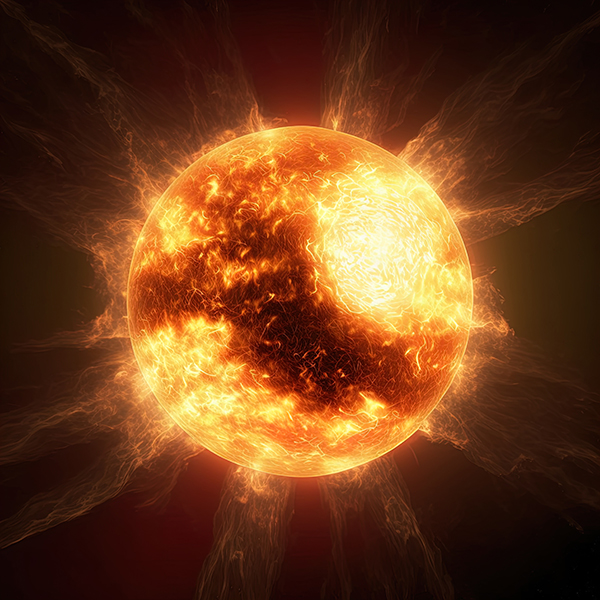Scientists discover elusive solar waves that could power the sun’s million-degree corona
10/27/2025 / By Belle Carter

- Scientists have detected torsional Alfvén waves in the sun’s corona using the Daniel K. Inouye Solar Telescope, confirming an 80-year-old theory about magnetic waves heating the corona to millions of degrees—far hotter than the sun’s surface.
- These twisting magnetic waves, first predicted by Hannes Alfvén in 1942, had remained hidden due to the corona’s chaotic plasma movements. Researchers isolated them using spectroscopic analysis, revealing their role in energy transfer.
- The discovery was made possible by the Inouye Solar Telescope’s Cryo-NIRSP instrument, which provides unprecedented detail of the corona. Northumbria University contributed key imaging technology and pioneered new analytical techniques.
- The torsional Alfvén waves may act as an “energy pipeline,” transporting heat from the sun’s interior to its outer atmosphere and fueling the solar wind. This could explain phenomena like “magnetic switchbacks” detected by NASA’s Parker Solar Probe.
- Understanding these waves enhances models of solar activity, thereby aiding forecasts of solar storms that can disrupt satellites, GPS, and power grids. The findings represent a significant breakthrough in solar research as the sun approaches its peak activity in 2025.
For nearly 80 years, scientists have theorized that mysterious magnetic waves could explain why the sun’s outer atmosphere, the corona, burns at millions of degrees Celsius—far hotter than its 5,500 C surface. Now, an international team led by researchers from Northumbria University has finally detected these elusive waves, known as torsional Alfvén waves, using the world’s most powerful solar telescope.
Published in Nature Astronomy, the discovery could reshape human understanding of solar energy transfer and space weather.
According to BrightU.AI‘s Enoch, Alfvén waves are magnetic disturbances that ripple through plasma—the superheated, electrically charged gas that makes up the sun. They were named after Swedish physicist Hannes Alfvén, who first predicted their existence in 1942. While scientists had previously observed larger Alfvén waves linked to solar flares, the small-scale torsional waves—which twist magnetic field lines back and forth—had remained undetected until now.
“The movement of plasma in the sun’s corona is dominated by swaying motions,” explained Professor Richard Morton, the study’s lead researcher and a UKRI Future Leader Fellow at Northumbria University. “These mask the torsional motions, so I had to develop a way of removing the swaying to find the twisting.”
Using the U.S. National Science Foundation’s Daniel K. Inouye Solar Telescope in Hawaii, Morton’s team analyzed the corona’s plasma, heated to 1.6 million C and identified the twisting waves through spectroscopic analysis—measuring subtle shifts in light as plasma moved toward and away from Earth.
A telescope built for discovery
The breakthrough was made possible by the Inouye Solar Telescope’s Cryogenic Near Infrared Spectropolarimeter (Cryo-NIRSP), the most advanced instrument of its kind for studying the corona. With a four-meter-wide mirror—four times larger than previous solar telescopes—it captures unprecedented detail in the sun’s outer atmosphere.
Northumbria University played a key role in developing cameras for the telescope’s Visible Broadband Imager, building on its expertise in solar observations. Morton secured early access to the telescope during its testing phase, allowing his team to pioneer new analytical techniques to isolate the torsional waves from the corona’s chaotic plasma movements.
“This discovery ends a protracted search for these waves that has its origins in the 1940s,” Morton said. “We’ve finally been able to directly observe these torsional motions twisting the magnetic field lines back and forth in the corona.”
The findings could solve one of the sun’s biggest mysteries: how the corona reaches such extreme temperatures. The torsional Alfvén waves may act as an energy pipeline, transporting heat from the sun’s interior to its outer atmosphere and fueling the solar wind—the stream of charged particles that fills the solar system.
Understanding these processes has real-world consequences. The solar wind carries magnetic disturbances that can disrupt satellite communications, GPS systems and power grids on Earth. Alfvén waves may also explain “magnetic switchbacks”—sudden reversals in the solar wind’s magnetic field detected by NASA’s Parker Solar Probe.
“This research provides essential validation for the range of theoretical models that describe how Alfvén wave turbulence powers the solar atmosphere,” Morton added. “Having direct observations finally allows us to test these models against reality.”
A new era of solar research
The discovery opens new avenues for studying wave dynamics in the corona and refining space weather forecasts. As solar activity increases toward its 2025 peak, predicting solar storms—which can knock out power grids and satellite networks—becomes ever more critical.
With the Inouye Solar Telescope now fully operational, scientists expect further revelations about the sun’s magnetic behavior.
“This is just the beginning,” Morton said. “Now that we can detect these waves, we can start unraveling how they contribute to heating the corona and accelerating the solar wind.”
For astrophysicists, the breakthrough marks the culmination of an eight-decade quest—and the start of a deeper exploration into the forces that shape our solar system.
Watch the video below that talks about harnessing solar energy.
This video is from the Alex Hammer channel on Brighteon.com.
Sources include:
Submit a correction >>
Tagged Under:
Alfven waves, breakthrough, corona, cosmic, Cryo-NIRSP, discoveries, NASA, research, scientific, solar storms, solar system, solar telescope, Space, sun, telescope
This article may contain statements that reflect the opinion of the author
RECENT NEWS & ARTICLES
COPYRIGHT © 2017 REAL SCIENCE NEWS




















